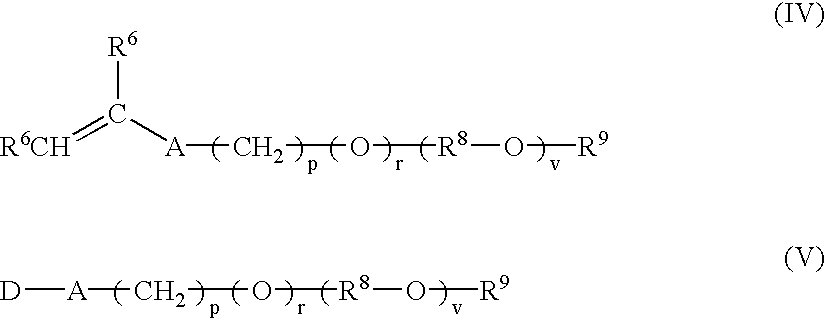Multi-purpose polymers, methods and compositions
a polymer and multi-purpose technology, applied in the field of anionic polymers, can solve the problems of increasing the amount of hase polymer not only economically undesirable, but the limited utility of hase polymers as rheology modifiers in aqueous formulations
- Summary
- Abstract
- Description
- Claims
- Application Information
AI Technical Summary
Benefits of technology
Problems solved by technology
Method used
Image
Examples
example 1
Polymers
[0134]The alkali-swellable associative polymer, identified as Polymer A in Table 2A, was prepared according to the general procedure described as Method H, and as described in detail below.
[0135]A monomer reaction mixture was prepared in a first reactor, under a nitrogen atmosphere, using an agitator mixer rotating at about 500 rpm, by combining about 117 parts by weight of methacrylic acid, about 172 parts by weight of ethyl acrylate, about 25.5 parts by weight of BEM25, and about 3.2 parts by weight of LEM23 into about 92 parts by weight of deionized water containing about 10.6 parts by weight of 30% aqueous sodium lauryl sulfate. To a second reactor, equipped with a mixing agitator, nitrogen inlet and feed pumps, were added about 570 parts by weight of deionized water and about 3.2 parts by weight of 30% aqueous sodium lauryl sulfate. The contents of the second reactor were heated with mixing agitation at a rotation speed of about 200 rpm under a nitrogen atmosphere. Afte...
examples 2-8
Aqueous Gels
[0144]The aqueous gels were prepared by diluting the product polymer emulsion with water to obtain the desired active polymer concentration and then neutralizing the diluted polymer emulsion with 2-amino-2-methyl-1-propanol (AMP, 95%) to a pH of about 5.8 to about 7.5, or until the composition was substantially clear. The % clarity value was obtained by Method B, the viscosity was measured by Method A. The results obtained are set forth in Table 3.
[0145]These examples illustrate the rheology modification and clarity achieved in aqueous gels containing the inventive polymers. Comparative Examples 2 and 3, illustrate the viscosity, and clarity of aqueous gels containing Comparative Polymer CP-1 of Example 1, a crosslinked, hydrophobically modified alkali-swellable emulsion (HASE) polymer having one associative monomer, in the amounts shown in Table 3. Examples 4 to 8 illustrate the thickening and clarity of aqueous gels containing, respectively, one the following inventive...
examples 9-11
Aqueous Gels
[0149]Examples 9-11 respectively illustrate the viscosity and clarity achieved in aqueous gels containing the inventive Polymers A, K and L of Example 1, each at active polymer concentrations of about 1.2 weight %, as shown in Table 4 below. Polymer A is a non-crosslinked analog of Polymer C of Example 5. Polymers K and L illustrate crosslinked polymers having different crosslinkers and varying hydrophobe content. The gels were prepared and neutralized to the pH indicated, and viscosity and % clarity determined as described in Examples 2-8.
[0150]
TABLE 4ViscosityViscosityEx.Poly.Wt %mPa · smPa · sNo.No.Poly.pH% ClarityImmed.24 hrs9A1.26.879.949,980116,20010K1.26.677.730,50062,60011L1.27.280.139,80086,800
[0151]As shown in Table 4, the gel made with the inventive non-crosslinked Polymer A (Ex. No. 9) had better clarity and higher viscosity than the gel containing non-crosslinked Polymer C of Example 5. The aqueous gels made with Polymers K and L (Ex. Nos. 10 and 11) also de...
PUM
| Property | Measurement | Unit |
|---|---|---|
| weight percent | aaaaa | aaaaa |
| weight percent | aaaaa | aaaaa |
| weight percent | aaaaa | aaaaa |
Abstract
Description
Claims
Application Information
 Login to View More
Login to View More - R&D
- Intellectual Property
- Life Sciences
- Materials
- Tech Scout
- Unparalleled Data Quality
- Higher Quality Content
- 60% Fewer Hallucinations
Browse by: Latest US Patents, China's latest patents, Technical Efficacy Thesaurus, Application Domain, Technology Topic, Popular Technical Reports.
© 2025 PatSnap. All rights reserved.Legal|Privacy policy|Modern Slavery Act Transparency Statement|Sitemap|About US| Contact US: help@patsnap.com



